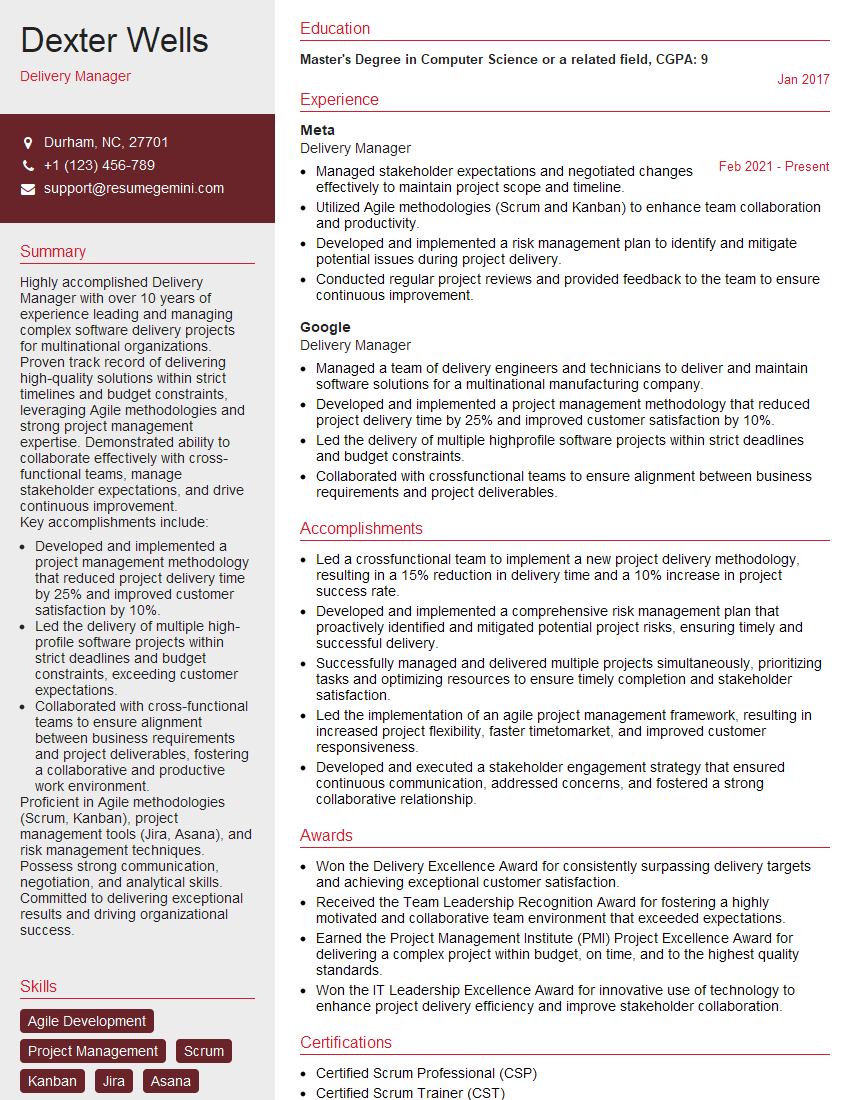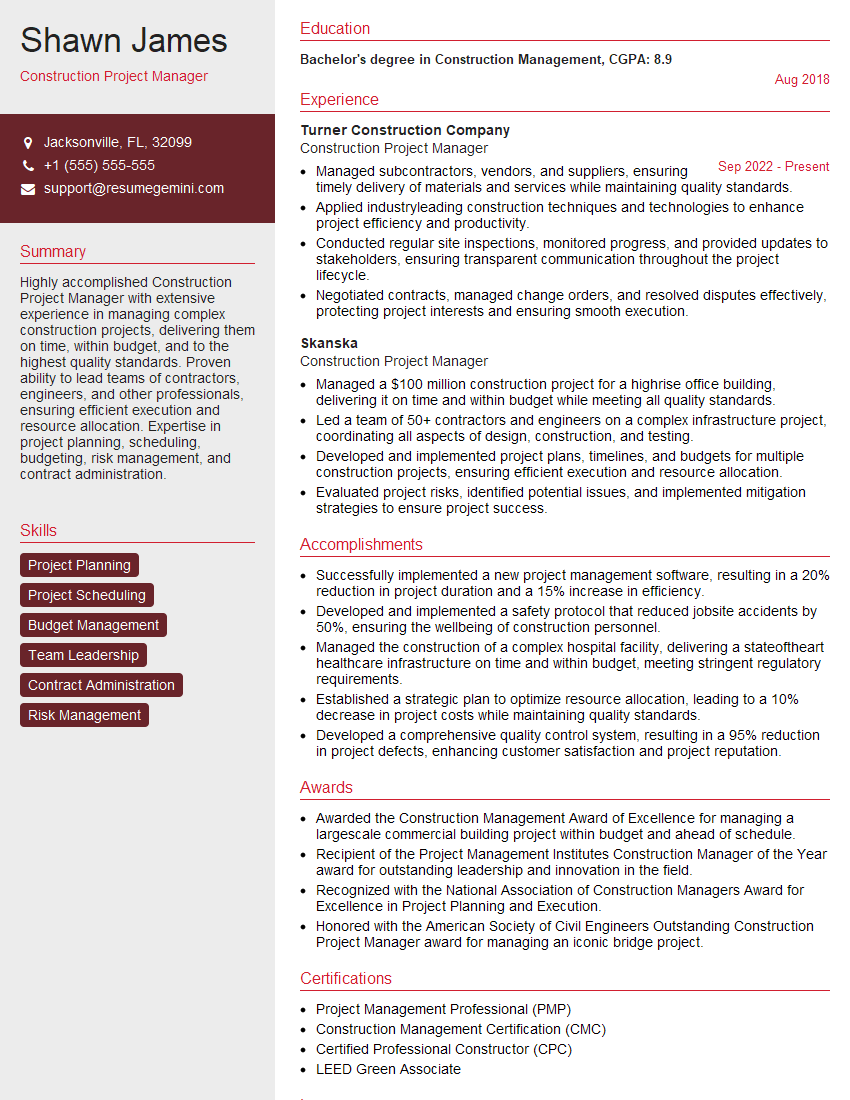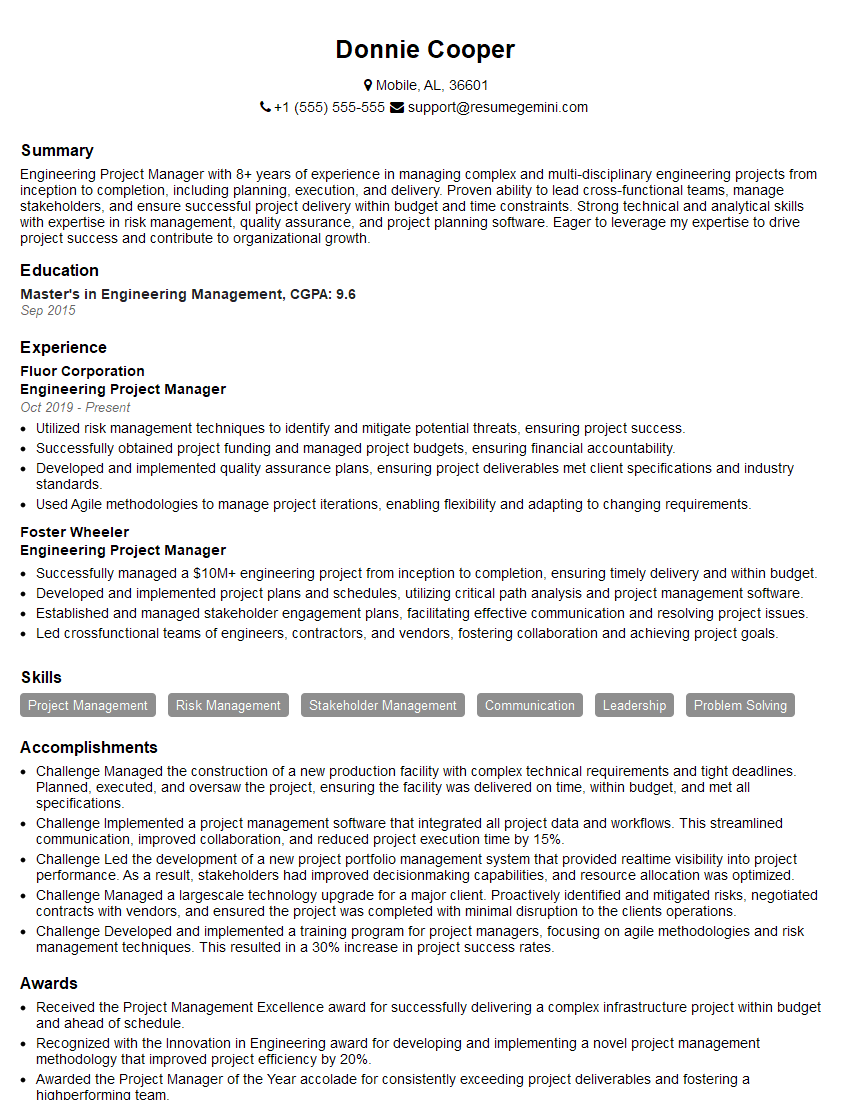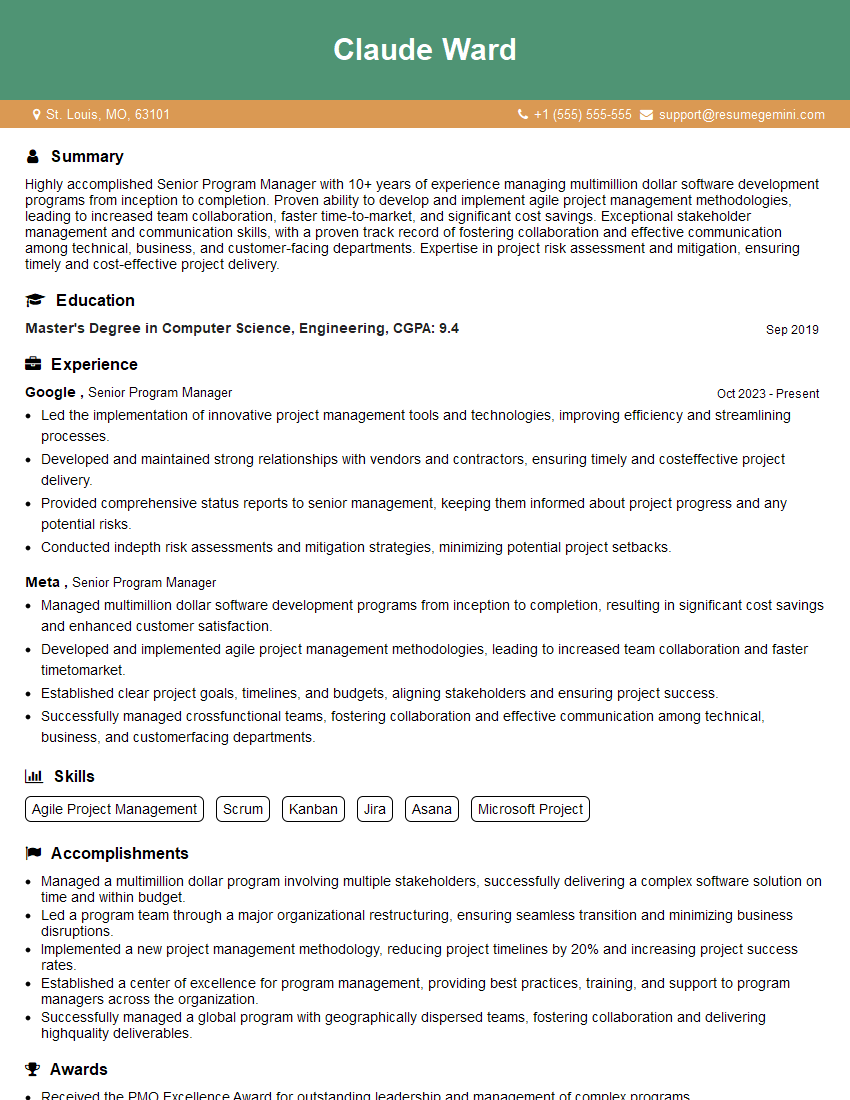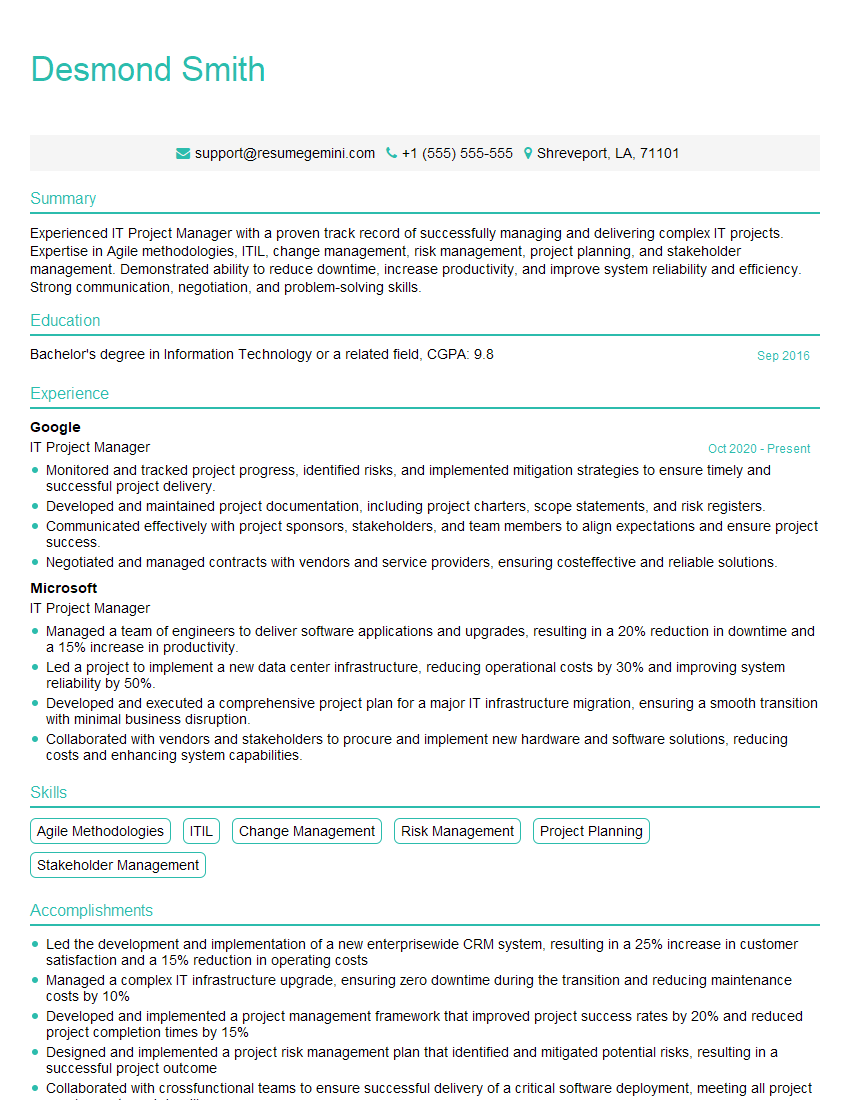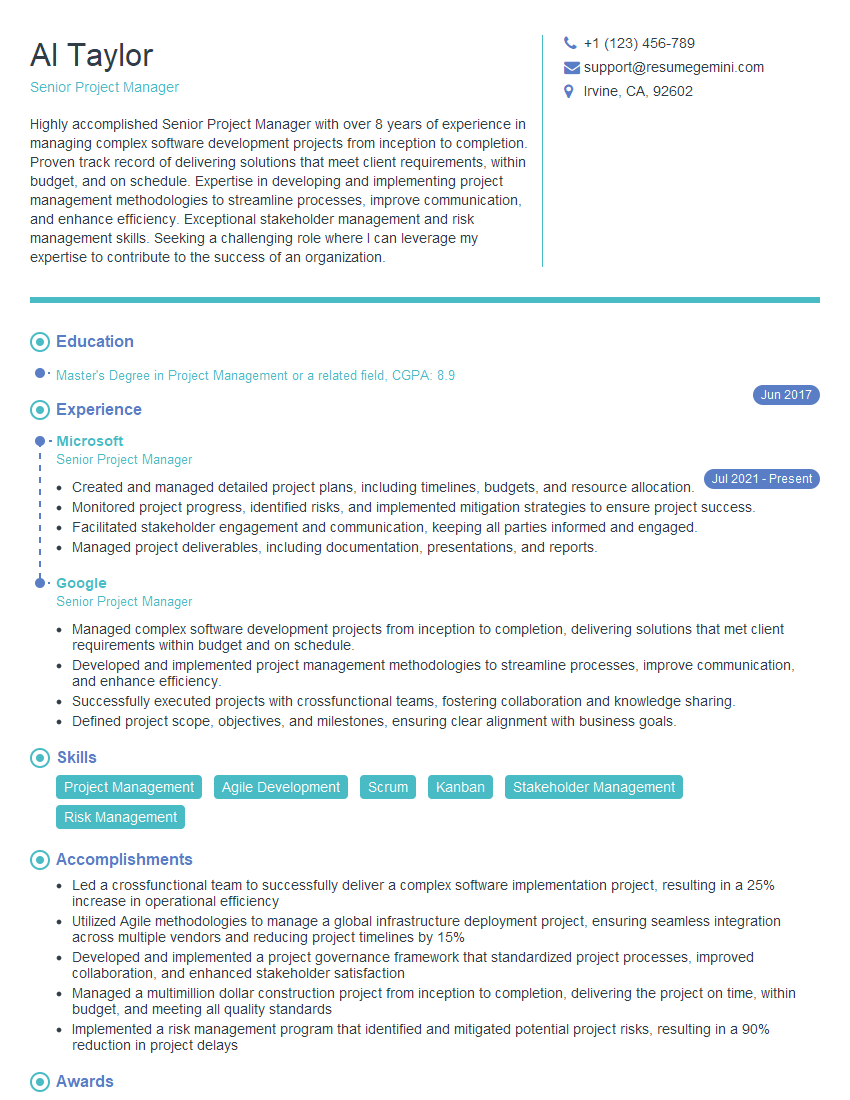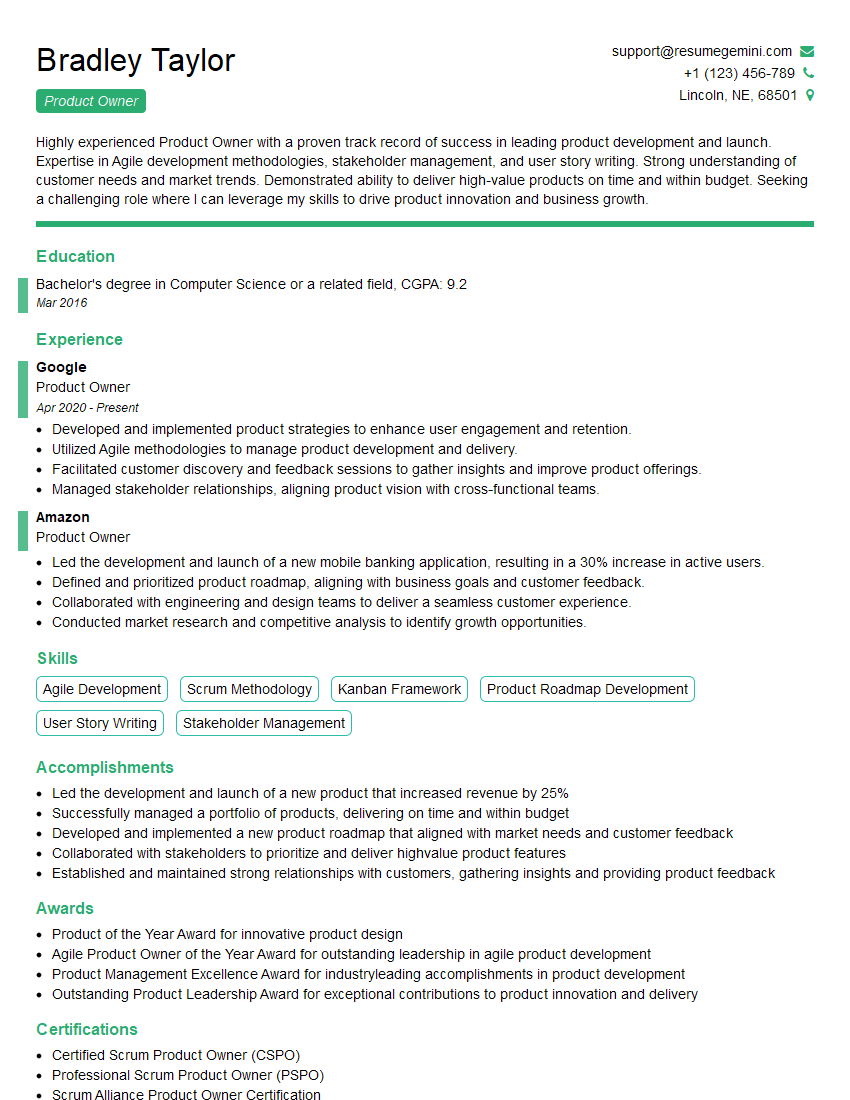Feeling uncertain about what to expect in your upcoming interview? We’ve got you covered! This blog highlights the most important Manage Multiple Projects interview questions and provides actionable advice to help you stand out as the ideal candidate. Let’s pave the way for your success.
Questions Asked in Manage Multiple Projects Interview
Q 1. Describe your experience managing multiple projects simultaneously.
Managing multiple projects simultaneously requires a structured approach and a keen eye for detail. It’s like conducting an orchestra – each instrument (project) needs to play its part in harmony, but each has its unique tempo and requirements. My experience involves successfully overseeing up to five projects concurrently, varying in size and complexity, from software development to marketing campaigns. This involved careful planning, prioritizing, and delegation to ensure each project remained on track and within budget.
I leverage project management software to track progress, deadlines, and resource allocation across all projects. This provides a centralized overview, minimizing the risk of overlooking crucial tasks or deadlines. Regular status meetings with team members are crucial to identifying and addressing potential roadblocks proactively.
Q 2. How do you prioritize tasks across different projects?
Prioritizing tasks across multiple projects is a critical skill. I employ a combination of methodologies, including MoSCoW (Must have, Should have, Could have, Won’t have) analysis and Eisenhower Matrix (Urgent/Important). The MoSCoW method helps categorize features by their necessity, allowing me to focus on the critical tasks first. The Eisenhower Matrix helps me identify urgent tasks requiring immediate attention and important tasks that contribute to long-term goals, even if they aren’t immediately pressing.
For example, if one project faces a critical deadline while another has less urgent milestones, I’d prioritize resources towards the impending deadline. This often requires careful communication with stakeholders to manage expectations and ensure everyone understands the rationale behind the prioritization.
Q 3. What methodologies do you utilize for managing multiple projects (e.g., Agile, Waterfall)?
My project management toolkit includes both Agile and Waterfall methodologies, selected based on the specific project needs. Waterfall is best suited for projects with clearly defined requirements and minimal anticipated changes. Agile, with its iterative approach, is ideal for projects that benefit from flexibility and frequent feedback, especially software development projects. In practice, I often use a hybrid approach, leveraging the strengths of each methodology.
For instance, for a large-scale software project, I would use an Agile framework like Scrum, incorporating daily stand-ups, sprint planning, and retrospectives. For a smaller, more predictable marketing campaign, a more structured Waterfall approach might be more suitable.
Q 4. Explain your approach to resource allocation in a multi-project environment.
Resource allocation across multiple projects demands a strategic and fair approach. I start by creating a detailed resource inventory, including team members’ skills, availability, and workload. Then, I analyze each project’s resource requirements, considering dependencies and critical paths. This analysis helps me identify potential bottlenecks and optimize resource allocation accordingly.
A key aspect is open communication with team members. I regularly consult with them to understand their workload and capacity, ensuring they aren’t overloaded. Tools like Gantt charts and resource allocation software help visualize the distribution and prevent over-allocation, maintaining a balance between project needs and team well-being.
Q 5. How do you handle conflicting priorities between different projects?
Conflicting priorities are inevitable when managing multiple projects. My approach involves proactive communication and negotiation with stakeholders. I clearly explain the constraints and trade-offs involved in prioritizing one project over another, providing transparent rationale to all parties. This often involves revisiting project scopes and adjusting deadlines where necessary.
For example, if two projects require the same team member at the same time, I would engage in a discussion to identify which project has a more critical deadline or higher business impact. Sometimes, this might involve adjusting the scope of one project or bringing in additional resources to address the conflict.
Q 6. How do you measure the success of multiple projects?
Measuring the success of multiple projects requires a multi-faceted approach. I define Key Performance Indicators (KPIs) for each project, aligning them with the overall business objectives. These KPIs could include things like on-time delivery, budget adherence, client satisfaction, and quality of deliverables. Regular monitoring of these KPIs provides insights into project performance and areas for improvement.
Beyond individual project success, I also assess the overall portfolio performance. This involves analyzing the aggregate performance of all projects, identifying trends, and making adjustments to the overall project management strategy based on the collective data. Regular reporting and presentations to stakeholders help maintain transparency and accountability.
Q 7. Describe a time you had to re-allocate resources due to unforeseen circumstances.
In one instance, a key team member unexpectedly left during a critical phase of a major software development project. This created a significant resource gap and threatened the project timeline. My immediate response involved assessing the remaining team’s capacity and expertise. We identified areas where tasks could be re-allocated or consolidated.
We also explored options such as outsourcing certain tasks or bringing in a temporary contractor with relevant skills. Open communication with the client was crucial to manage expectations and obtain their agreement on the revised timeline. Through careful planning and decisive action, we managed to mitigate the impact of the unforeseen circumstance and complete the project with minimal delays.
Q 8. How do you use project management software to manage multiple projects?
Project management software is indispensable when juggling multiple projects. I leverage its capabilities to centralize information, track progress, and manage resources effectively. For example, I utilize tools like Asana, Jira, or Monday.com to create individual project boards for each initiative. These boards contain task lists, deadlines, assigned team members, and progress tracking features. The software allows for the creation of custom views (Kanban, Gantt charts, calendars) to visualize project timelines and dependencies across all projects simultaneously. This allows for a bird’s-eye view of my workload and helps me prioritize tasks based on urgency and importance. Furthermore, features like reporting and analytics provide crucial insights into overall project health, identifying potential roadblocks before they escalate.
For instance, in a previous role, we used Jira to manage the development of three distinct software applications concurrently. Each application had its own project board, but the system’s reporting tools allowed me to generate cross-project reports showcasing resource allocation, total project hours, and potential bottlenecks. This holistic view enabled proactive resource management and prevented critical delays.
Q 9. What strategies do you employ to mitigate risks across multiple projects?
Mitigating risks across multiple projects requires a proactive and systematic approach. I employ a multi-layered strategy that starts with identifying potential risks early in the planning phase of each project. This involves brainstorming sessions with the project teams and using tools like SWOT analysis and risk registers to document identified risks, assess their probability and impact, and develop mitigation plans. The key is to not only identify risks specific to each project but also those that could impact multiple projects simultaneously – such as resource constraints or unexpected market changes.
Once risks are identified, I prioritize them based on their severity and develop mitigation strategies. These strategies can range from simple contingency plans (e.g., having backup resources available) to more complex strategies such as implementing risk transfer mechanisms (e.g., insurance) or developing detailed risk response plans. Regular risk reviews, ideally incorporated into project status meetings, ensure that mitigation plans are being followed and that new risks are promptly identified and addressed.
For example, during the launch of a new product line, I identified the risk of supplier delays. By diversifying suppliers and building in buffer time into the project schedule, I mitigated the impact of potential delays on subsequent projects that were dependent on this product line’s launch.
Q 10. How do you communicate project status updates to stakeholders across multiple projects?
Effective communication is vital when managing multiple projects. I establish a standardized reporting system to ensure consistent and timely updates to all stakeholders. This might involve weekly or bi-weekly status reports delivered through email or project management software, including concise summaries of each project’s progress, key milestones reached, and any roadblocks encountered.
To further enhance communication, I leverage regular meetings, both at the individual project level and at a portfolio level, to discuss overarching progress and address any cross-project issues. Using visual aids such as dashboards or charts helps in presenting complex information clearly and concisely. I tailor the communication style and level of detail to the specific audience, ensuring that executive summaries for senior management differ from detailed technical updates for project teams.
For instance, I once used a centralized dashboard in Monday.com to provide stakeholders across multiple projects with a real-time overview of project progress, key performance indicators (KPIs), and potential issues. This fostered transparency and enabled early identification and resolution of potential problems.
Q 11. How do you build and maintain strong relationships with stakeholders in a multi-project environment?
Building and maintaining strong stakeholder relationships is crucial for successful multi-project management. I prioritize open and honest communication, ensuring regular updates and proactive engagement with stakeholders. This includes setting clear expectations from the outset, establishing clear communication channels, and actively soliciting feedback. Active listening and empathy are key to understanding stakeholders’ concerns and adapting my communication and project approach accordingly.
I establish regular check-ins (e.g., weekly calls, monthly meetings) with key stakeholders to maintain a close working relationship and ensure that their needs are being met. I also take the time to understand their priorities and concerns, adapting my approach as needed to ensure alignment between project goals and stakeholder expectations. Finally, celebrating successes together and openly addressing challenges builds trust and strengthens the working relationships.
In a past project, I built strong relationships with key stakeholders by regularly sharing progress reports, actively seeking their feedback, and proactively addressing their concerns. This collaboration fostered trust and ensured that the projects remained aligned with their strategic objectives.
Q 12. What are your strategies for managing project dependencies?
Managing project dependencies in a multi-project environment requires careful planning and coordination. I utilize tools like Gantt charts and dependency mapping to visualize the relationships between different projects and tasks. This allows me to identify potential conflicts and dependencies early on, enabling proactive scheduling and resource allocation.
I use a dependency matrix to document and track all interdependencies between projects. This matrix clearly shows which projects are dependent on the completion of others, and which tasks need to be completed before others can start. Critical path analysis helps in identifying the most time-sensitive tasks and helps prioritize resources accordingly. Using project management software with integrated dependency tracking further helps in automatically alerting me to potential delays or conflicts based on changes to task completion.
For example, in one project, we needed to launch a new website (Project A) before starting a related marketing campaign (Project B). The Gantt chart clearly showed this dependency, allowing us to allocate resources and adjust timelines for both projects to avoid delays. If Project A had been delayed, it would have directly impacted Project B’s timeline, which would then have affected other downstream projects. The dependency matrix and Gantt chart allowed for proactive adjustments and risk mitigation.
Q 13. Describe your experience with project portfolio management.
Project portfolio management (PPM) is about strategically managing a collection of projects to achieve organizational goals. My experience in PPM includes developing and implementing portfolio strategies, prioritizing projects based on strategic alignment and resource availability, and monitoring the overall performance of the portfolio. This involves using various techniques to assess the value and risk associated with each project, ensuring that the portfolio is balanced and aligned with overall organizational objectives.
I have used PPM methodologies like balanced scorecard and portfolio optimization techniques to prioritize projects and make resource allocation decisions that maximize return on investment (ROI). This includes creating a clear framework for evaluating projects based on criteria such as strategic importance, financial viability, and risk. Regular portfolio reviews and reporting to senior management are crucial to ensuring that the portfolio continues to be aligned with organizational goals and that adjustments can be made as needed.
In a previous role, I successfully implemented a PPM system that improved the prioritization of projects, resulting in a 15% increase in the completion of high-priority projects within budget and on time. This was achieved by using a scoring model that weighted strategic importance, ROI, and risk.
Q 14. How do you identify and address project bottlenecks across multiple projects?
Identifying and addressing bottlenecks across multiple projects is a continuous process that requires vigilant monitoring and proactive intervention. I use several methods to identify bottlenecks, including regular project status meetings, reviewing project timelines and resource allocation, and analyzing project management software data (e.g., task durations, resource utilization). Bottlenecks can often be related to resource constraints, dependencies between tasks or projects, or unforeseen issues.
Once a bottleneck is identified, I analyze its root cause. This might involve conducting a root cause analysis (RCA) to pinpoint the underlying issues. Solutions may include reallocating resources, adjusting project timelines, resolving technical issues, or seeking additional support. Communication with the relevant stakeholders is critical to implementing solutions and ensuring that they are accepted and supported.
For example, in a past project, we identified a bottleneck due to a single team member being overloaded with tasks. By re-allocating some of their tasks to other team members and clarifying dependencies, we were able to alleviate the bottleneck and ensure that the project stayed on track. Continuous monitoring after the solution is applied helps ensure it was truly effective and prevent the same issue from reoccurring.
Q 15. How do you ensure consistent quality across multiple projects?
Maintaining consistent quality across multiple projects requires a proactive, multi-faceted approach. It’s not enough to simply define quality standards; you must actively monitor, measure, and improve them consistently. Think of it like baking a batch of cookies – you need the same recipe (standards), the same ingredients (resources), and the same baking time (process) for each batch to achieve consistent results.
- Standardized Processes: Implementing standardized project management methodologies (like Agile or Waterfall) across all projects ensures a consistent framework for planning, execution, and monitoring. This includes using consistent templates for project plans, risk assessments, and quality control checks.
- Regular Quality Audits: Conduct regular audits to assess adherence to quality standards. These audits shouldn’t just focus on the final product but also on the processes used throughout the project lifecycle. This provides early identification of potential issues.
- Cross-Project Knowledge Sharing: Foster a culture of collaboration and knowledge sharing between project teams. Sharing best practices and lessons learned from one project can significantly improve the quality of others. This might involve regular team meetings or a central knowledge base.
- Defined Quality Metrics: Establish clear, measurable quality metrics specific to each project and track them consistently. This could include defect rates, customer satisfaction scores, or adherence to deadlines. Regular review of these metrics allows for timely adjustments.
For example, in my previous role, we implemented a standardized checklist for all software development projects, covering aspects like code reviews, testing protocols, and documentation. This led to a significant reduction in post-launch defects across all our projects.
Career Expert Tips:
- Ace those interviews! Prepare effectively by reviewing the Top 50 Most Common Interview Questions on ResumeGemini.
- Navigate your job search with confidence! Explore a wide range of Career Tips on ResumeGemini. Learn about common challenges and recommendations to overcome them.
- Craft the perfect resume! Master the Art of Resume Writing with ResumeGemini’s guide. Showcase your unique qualifications and achievements effectively.
- Don’t miss out on holiday savings! Build your dream resume with ResumeGemini’s ATS optimized templates.
Q 16. Describe your experience with project reporting and analysis across multiple projects.
Project reporting and analysis across multiple projects requires a system for collecting, consolidating, and interpreting data from diverse sources. Imagine a dashboard showing the overall health of all your projects at a glance – that’s the goal. Effective reporting should highlight both successes and challenges, providing actionable insights for improvement.
- Centralized Reporting System: Using a project management software (like Jira, Asana, or Microsoft Project) allows for centralized data collection and reporting. This streamlines the process of generating reports on project status, budget, and risks.
- Customizable Reports: The ability to generate customized reports tailored to specific stakeholders’ needs is crucial. For instance, executive summaries focus on high-level metrics, while detailed reports are essential for project managers.
- Data Visualization: Using charts, graphs, and dashboards to present data visually makes it easier to understand complex information and identify trends. This allows for quicker identification of potential roadblocks or successes.
- Regular Reporting Cadence: Establishing a regular reporting cadence, such as weekly or monthly reports, ensures consistent monitoring of project progress and early detection of issues.
In my experience, I’ve successfully used data visualization techniques to present complex project data to senior management, highlighting areas needing attention and showcasing the overall progress of multiple, simultaneous projects. For instance, I created a dashboard that clearly showed project timelines, budget utilization, and risk probabilities, allowing for proactive decision-making.
Q 17. How do you manage project budgets across multiple projects?
Managing project budgets across multiple projects necessitates a holistic approach that balances individual project needs with overall resource allocation. It’s like managing a household budget – you need to allocate funds to various areas (projects) while staying within your overall financial limits.
- Centralized Budget Tracking: A centralized system for tracking budgets across all projects is essential. This allows for a clear overview of spending and remaining funds.
- Resource Allocation Strategies: Develop strategies for allocating resources (both financial and human) across projects based on priority and potential return on investment. This might involve a weighted scoring system to prioritize projects.
- Regular Budget Reviews: Conduct regular budget reviews to monitor spending, identify variances, and make necessary adjustments. This ensures that projects stay within budget and resources are used efficiently.
- Contingency Planning: Include contingency funds in the overall budget to accommodate unforeseen expenses or delays. This acts as a buffer to protect against unexpected issues.
In a past role, I implemented a system for allocating resources based on a weighted scoring system that considered factors such as project urgency, strategic importance, and potential ROI. This ensured that the most critical projects received adequate resources, maximizing overall value delivery.
Q 18. What is your experience with change management in a multi-project context?
Change management in a multi-project context is particularly challenging because changes in one project can have ripple effects on others. Think of it as a game of dominoes – one falling domino can trigger a chain reaction. Effective change management requires a proactive, structured approach.
- Clear Change Management Process: Establish a clear, documented process for managing changes across all projects. This includes defining who approves changes, how changes are documented, and how their impact is assessed.
- Impact Assessment: Before implementing any change, conduct a thorough impact assessment to understand its potential effects on other projects, timelines, and resources.
- Communication Plan: Develop a robust communication plan to keep all stakeholders informed of changes and their potential impact. This reduces uncertainty and fosters cooperation.
- Change Control Board: Establish a change control board (CCB) to review and approve proposed changes. This ensures that changes are well-considered and aligned with overall organizational goals.
In one instance, a significant change request arose on a major project that would have impacted several dependent projects. By using our established change management process, including a thorough impact assessment and clear communication with all affected teams, we managed to implement the change with minimal disruption to other ongoing projects.
Q 19. How do you deal with project scope creep across multiple projects?
Project scope creep, the uncontrolled expansion of project requirements, is a common problem in multi-project environments. It’s like adding more ingredients to a recipe without adjusting the baking time – the final product might be compromised. Effective prevention and mitigation strategies are vital.
- Clearly Defined Scope: Ensure that each project has a clearly defined and documented scope statement. This serves as a baseline for measuring progress and identifying any deviations.
- Regular Scope Reviews: Conduct regular scope reviews to ensure that the project remains within its defined boundaries. This involves comparing actual work against the planned scope.
- Change Control Process: Utilize a formal change control process to manage any requests for scope changes. This process should involve assessing the impact on other projects and resources before approving any changes.
- Stakeholder Management: Engage stakeholders early and frequently to manage expectations and ensure that everyone understands the project’s defined scope.
In a previous role, we experienced scope creep on one project. By implementing a stricter change control process and reinforcing communication with stakeholders, we managed to prevent further scope creep and successfully delivered the project on time and within budget.
Q 20. How do you delegate tasks effectively when managing multiple projects?
Effective delegation when managing multiple projects involves identifying the right person for the right task, providing clear instructions, and establishing accountability. It’s like orchestrating a symphony – each musician (team member) needs to play their part correctly for the overall performance (project) to succeed.
- Skill Assessment: Assess the skills and experience of team members to match tasks with individuals who possess the necessary competencies.
- Clear Expectations: Provide clear and concise instructions, setting specific deadlines and expectations for each task. Ensure understanding through open communication.
- Authority and Accountability: Delegate appropriate authority to team members, but also establish clear accountability for the successful completion of tasks. This fosters ownership and responsibility.
- Regular Check-ins: Conduct regular check-ins with team members to monitor progress, provide support, and address any challenges.
I often utilize a task management system where each task is assigned to a specific team member, with clear deadlines and expectations. Regular check-ins help identify and resolve potential roadblocks before they impact project timelines.
Q 21. How do you stay organized when managing numerous tasks across several projects?
Staying organized while managing numerous tasks across several projects requires a structured approach combining technology and effective organizational strategies. It’s like organizing a complex puzzle – each piece (task) needs to be in its right place for the whole picture (projects) to be clear.
- Project Management Software: Utilize project management software (like Asana, Trello, or Monday.com) to centralize tasks, deadlines, and communications across all projects. This provides a single source of truth for all project-related information.
- Prioritization Techniques: Employ prioritization techniques (like Eisenhower Matrix or MoSCoW method) to focus on the most critical tasks first. This ensures that your energy is directed towards high-impact activities.
- Time Management Strategies: Implement time management techniques (like time blocking or Pomodoro Technique) to allocate specific time slots for working on different projects. This helps maintain focus and prevent task switching.
- Regular Review and Adjustment: Schedule regular time for reviewing progress, adjusting priorities, and addressing any emerging issues. This ensures that you remain on top of things and can adapt to changing circumstances.
Personally, I combine the use of a project management tool with a personal planner to organize my day and week, allocating specific time slots for working on various projects. Regular reviews allow for adjustments to my schedule based on changing priorities or unexpected challenges.
Q 22. Describe your approach to conflict resolution when managing multiple projects.
My approach to conflict resolution prioritizes collaboration and understanding. I believe that conflicts, when handled effectively, can lead to improved processes and stronger team bonds. My process involves:
- Active Listening: I ensure all parties feel heard and understood before attempting to find a solution. This involves asking clarifying questions and paraphrasing to confirm understanding.
- Identifying the Root Cause: Instead of focusing on the symptoms of conflict, I delve into the underlying issues driving the disagreement. This might involve individual personality clashes, resource constraints, or unclear project goals.
- Collaborative Problem-Solving: Once the root cause is understood, I facilitate a collaborative discussion to find mutually agreeable solutions. I encourage brainstorming and compromise, focusing on solutions that benefit the overall project goals.
- Documentation and Follow-up: Agreements reached are documented clearly and concisely. I also follow up to ensure the agreed-upon solutions are implemented and to address any lingering concerns.
For example, in a previous project, two team members had conflicting opinions about the best approach to a design problem. Instead of imposing a solution, I facilitated a workshop where they presented their ideas and collaboratively developed a hybrid approach that incorporated the best elements of both.
Q 23. What is your experience with risk assessment and mitigation in a multi-project setting?
Risk assessment and mitigation are crucial when managing multiple projects. I utilize a proactive approach, combining qualitative and quantitative methods. My process includes:
- Identifying Potential Risks: This involves brainstorming sessions with project teams, reviewing past project experiences, and considering external factors like market trends and economic conditions.
- Assessing Risk Probability and Impact: Each identified risk is assessed based on its likelihood of occurring and its potential impact on the project timelines, budget, and quality.
- Developing Mitigation Strategies: For each high-priority risk, I develop specific mitigation plans outlining preventative measures and contingency plans if the risk materializes.
- Monitoring and Review: Risks are continuously monitored, and the mitigation plans are reviewed and updated as the projects progress. This ensures adaptability to changing circumstances.
For instance, in a past project involving multiple software releases, we identified the risk of a critical dependency failing. We mitigated this by implementing rigorous testing, creating a rollback plan, and establishing clear communication channels between teams to promptly address any issues.
Q 24. How do you ensure team morale and motivation when managing multiple projects?
Maintaining high team morale and motivation is paramount when juggling multiple projects. I focus on building a strong team culture and providing regular support and recognition. My strategies include:
- Clear Communication: Keeping everyone informed about project progress, challenges, and upcoming deadlines is crucial. I utilize regular team meetings, project updates, and informal communication channels.
- Empowerment and Autonomy: I empower team members by giving them ownership of their tasks and allowing them to make decisions within their areas of responsibility. This fosters a sense of responsibility and engagement.
- Recognition and Appreciation: Regularly acknowledging individual and team achievements, both big and small, significantly boosts morale. This can involve verbal praise, public acknowledgment, or small rewards.
- Work-Life Balance: I advocate for a healthy work-life balance to prevent burnout. This includes encouraging taking breaks, utilizing available vacation time, and setting realistic expectations.
I believe that a happy and motivated team is a productive team, and I prioritize creating a supportive and inclusive environment.
Q 25. What metrics do you track to monitor the overall health of your projects?
To monitor the overall health of my projects, I track a range of key metrics, including:
- Project Schedule: Tracking progress against the baseline schedule to identify potential delays.
- Budget: Monitoring actual spending against the allocated budget to manage costs effectively.
- Resource Utilization: Assessing how efficiently resources (personnel, equipment, materials) are being utilized.
- Quality Metrics: Measuring the quality of deliverables, including defect rates and customer satisfaction.
- Risk Register Status: Tracking the status of identified risks and the effectiveness of mitigation strategies.
I utilize project management software to automate the collection and analysis of these metrics, allowing for real-time monitoring and early identification of potential issues.
Q 26. How do you handle project delays or setbacks across multiple projects?
Handling project delays or setbacks requires a proactive and systematic approach. My process involves:
- Identifying the Root Cause: Thoroughly investigate the reasons for the delay to prevent similar issues from recurring.
- Assessing Impact: Evaluate the impact of the delay on other projects and stakeholders.
- Developing Recovery Plan: Create a detailed plan to get the project back on track, which might involve adjusting the scope, re-allocating resources, or extending deadlines.
- Communication: Keep all stakeholders informed about the delay and the recovery plan.
- Lessons Learned: Document the cause of the delay and the lessons learned to prevent similar issues in future projects.
Transparency and clear communication are key during this process. For example, if a critical dependency is delayed, I would immediately communicate this to all affected parties, adjust the schedule accordingly, and explore alternative solutions.
Q 27. Describe a time you successfully managed multiple competing deadlines.
In a previous role, I managed three projects with overlapping deadlines. One involved a critical software release, another a major marketing campaign, and the third a crucial client presentation. The deadlines were tightly packed and interdependent. To manage this, I employed the following strategies:
- Prioritization: I carefully prioritized tasks based on their urgency and impact, focusing first on the most critical deliverables.
- Resource Allocation: I strategically allocated resources (team members, budget) to ensure each project received the necessary support at the right time.
- Detailed Scheduling: I created a detailed project schedule that outlined all tasks and dependencies, allowing for efficient tracking and proactive management of potential conflicts.
- Regular Communication: I held frequent meetings with each project team to discuss progress, address challenges, and coordinate efforts.
- Contingency Planning: I developed contingency plans to address potential delays or unexpected challenges.
Through meticulous planning, proactive communication, and effective resource allocation, all three projects were successfully completed on time and to a high standard.
Q 28. How do you adapt your management style based on the individual needs of different projects?
My management style is adaptable and responsive to the individual needs of different projects. I don’t believe in a one-size-fits-all approach. Instead, I tailor my approach based on factors like project size, complexity, team dynamics, and client expectations. For example:
- Small, simple projects: May require a more hands-on, directive approach, providing clear instructions and regular check-ins.
- Large, complex projects: Benefit from a more collaborative and empowering style, delegating responsibilities and fostering teamwork.
- Projects with high risk tolerance: May call for a more agile and iterative approach, adapting plans as needed.
- Projects with stringent regulatory requirements: Require a more structured and formal management style, ensuring compliance with all relevant regulations.
The key is to be flexible and responsive to the unique demands of each project while maintaining consistency in communication and expectations.
Key Topics to Learn for Manage Multiple Projects Interview
- Project Prioritization & Planning: Understanding methodologies like MoSCoW, Eisenhower Matrix, and Agile frameworks for effectively prioritizing tasks and allocating resources across multiple projects.
- Resource Allocation & Management: Practical application of resource allocation strategies, including balancing team workloads, delegating tasks effectively, and managing budgets across projects.
- Risk Management & Mitigation: Identifying potential risks and developing proactive mitigation strategies for each project, considering their interconnectedness.
- Communication & Collaboration: Effective communication strategies for keeping stakeholders informed, facilitating cross-project collaboration, and resolving conflicts.
- Project Monitoring & Reporting: Utilizing various tools and techniques to track project progress, analyze key performance indicators (KPIs), and report on status to management.
- Problem-Solving & Decision-Making: Developing and applying problem-solving approaches to address challenges impacting multiple projects simultaneously, making informed and timely decisions.
- Tools & Technologies: Familiarity with project management software (e.g., Asana, Trello, Jira) and their application in managing multiple projects concurrently.
- Agile Methodologies (Scrum, Kanban): Understanding and applying agile principles to manage complex projects and adapt to changing requirements effectively.
Next Steps
Mastering the art of managing multiple projects is crucial for career advancement, opening doors to leadership roles and higher earning potential. A well-crafted, ATS-friendly resume is your key to unlocking these opportunities. ResumeGemini can help you create a professional and impactful resume that showcases your project management skills. We offer examples of resumes tailored to highlight expertise in managing multiple projects, giving you a head start in your job search. Invest in your future – build a standout resume with ResumeGemini today.
Explore more articles
Users Rating of Our Blogs
Share Your Experience
We value your feedback! Please rate our content and share your thoughts (optional).
What Readers Say About Our Blog
Live Rent Free!
https://bit.ly/LiveRentFREE
Interesting Article, I liked the depth of knowledge you’ve shared.
Helpful, thanks for sharing.
Hi, I represent a social media marketing agency and liked your blog
Hi, I represent an SEO company that specialises in getting you AI citations and higher rankings on Google. I’d like to offer you a 100% free SEO audit for your website. Would you be interested?


